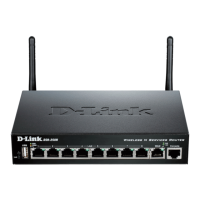Unified Services Router User Manual
58
Figure 37: OSPFv2 configured parameters
Interface: The physical network interface on which OSPFv2 is Enabled/Disabled.
Status: This column displays the Enable/Disable state of OSPFv2 for a particular interface.
Area: The area to which the interface belongs. Two routers having a common segment; their
interfaces have to belong to the same area on that segment. The interfaces should belong to the same
subnet and have similar mask.
Priority: Helps to determine the OSPFv2 designated router for a network. The router with the highest
priority will be more eligible to become Designated Router. Setting the value to 0, makes the router
ineligible to become Designated Router. The default value is 1.Lower value means higher priority.
HelloInterval: The number of seconds for HelloInterval timer value. Setting this value, Hello packet
will be sent every timer value seconds on the specified interface. This value must be the same for all
routers attached to a common network. The default value is 10 seconds.
DeadInterval: The number of seconds that a device’s hello packets must not have been seen before its
neighbors declare the OSPF router down. This value must be the same for all routers attached to a
common network. The default value is 40 seconds.
OSPF requires these intervals to be exactly the same between two neighbors. If any of these intervals
are different, these routers will not become neighbors on a particular segment
Cost: The cost of sending a packet on an OSPFv2 interface.
Authentication Type:. This column displays the type of authentication to be used for OSPFv2.If
Authentication type is none the interface does not authenticate OSPF packets. If Authentication Type
is Simple then OSPF packets are authenticated using simple text key. If Authentication Type is MD5
then the interface authenticates OSPF packets with MD5 authentication.

